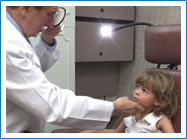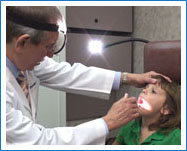Tonsillectomies and Relief from Chronic Childhood Infections
Removing enlarged and/or infected tonsils allows a child to recover from chronic infection and upper airway obstruction.
Symptoms
The tonsils are a mass of round, marble-sized reddish/pink tissue located on either side of the mouth at the base of the tongue. During throat infections and certain allergies, the tonsils may become infected themselves, becoming swollen and enlarged. They also occasionally develop an abscess which is another cause for removal.Some symptoms of tonsillitis and/or enlarged tonsils are:
- Persistent difficulty with swallowing
- Severe speech problems
- Nasal speech
- Abnormal development of the bones which hold the teeth
- Poor sleeping patterns and occasional bed-wetting
- Noisy breathing and other breathing problems
- Loss of appetite
- Poor weight gain
- Early morning headaches
- Chronic sore throat and recurrent strep throat
- Chronic bad breath
- Choking
The Surgical Procedure
Tonsillectomies are frequently performed operations lasting approximately 20-30 minutes. They are outpatient procedures performed under general anesthesia.

Aspirin or aspirin-like products should be avoided for 1-2 weeks prior to and after surgery, unless otherwise indicated.
For seven to ten days following surgery, the child will experience some pain in the ears and throat. This is usually controlled with medication received at the hospital. Chewing gum and warm cloths or heat helps relieve some of the soreness.
We recommend a cold liquid and soft diet for the first 24 hours following surgery. On the second day, the child may drink warm liquids and eat any food they can tolerate. Do not be worried if the child eats very little, but be sure they drink at least one quart of liquid per day. Loss of appetite is common after this type of surgery. Increased liquid intake and Tylenol should control fever.
Bleeding after surgery is rare; however it can occur for up to two weeks following surgery. If you see bright red blood, please call the office for immediate instructions. Otherwise, the child may simply be coughing up some dark flecks of blood as the scabs free themselves from the back of the throat between the fifth and tenth days after surgery. Breath odor and a thick yellow cover over the surgical site are also not unusual. It is a normal part of the healing process. Also do not be alarmed if the child experiences a slight voice change. This may be a normal part of the healing process.
Do not allow the child out of the house until the second day after surgery. Strenuous activity is prohibited for about ten days, but they may play outdoors after the second day. The child may return to school when they feel ready, usually four to seven days after surgery. The child should return for a follow-up examination in 2-4 weeks after the surgery. Please call to schedule an appointment. Again, if there are any questions in the meantime, call our offices.
Adult Tonsillectomies and Relief from Chronic Sore Throats
Adults undergo tonsillectomies for the same reasons as children: chronic infections that do not respond to antibiotics or large tonsils causing airway obstruction and snoring.
Symptoms
Some symptoms of tonsillitis in adults are:- Persistent difficulty with swallowing
- Noisy breathing and other breathing problems
- Chronic sore throat and recurrent strep throat
- Chronic bad breath
- Hoarseness
- Throat infections which cause frequent absence from work
- Lymph glands which remain swollen for six months or more.
- Abscess on the tonsils
- Fever
- Snoring
The Surgical Procedure
After examination, your condition and the surgical procedure will be explained to you. You will also be provided with written descriptions of the procedure and follow-up home care. Please contact us at any time with questions or for clarification.A tonsillectomy is a safe operation that lasts about 20-30 minutes. Aspirin or aspirin-like products should be avoided for 2-3 weeks prior to and after surgery, unless otherwise indicated.
This out-patient procedure requires general anesthesia. This means that some time will be spent in the recovery room.
Pain in the ears an throat following surgery can be reasonably controlled with medication. Ice packs may be applied for the first 24-48 hours. Salt water gargles, chewing gum or heat can relieve some of the soreness.
We recommend a cold liquid and soft diet for the first 24 hours following surgery. On the second day, you may drink warm liquids and eat any food you can tolerate. Be sure to drink at least three quarts of fluid daily. Increased liquid intake and Tylenol should help control forever.
Bleeding after surgery is rare, however it can occur for up to two weeks after surgery. If bright red blood is seen, please call the office for instruction. Otherwise, you may simply be coughing up some dark flecks of blood as the scabs free themselves from the back of the throat between the fifth and tenth days after surgery. A “whitish” coating in the back of the throat is not unusual. Breath odor and a slight voice change are also not unusual and may be a normal part of the healing process.
Strenuous activity is prohibited far about 14 days. You may return to work (or school) when you feel ready, usually four to seven days after surgery. A follow-up examination should be scheduled for 3-4 weeks after the surgery. Please call for an appointment.
Adenoidectomies and Restoration of a Child’s Health and Development
Removing the adenoids allows a child to recover from chronic infections and improves the ability to breathe. It is commonly related to tonsillitis; thus, it is not unusual to remove the adenoids and tonsils at the same time.
Symptoms
The adenoids are located behind the nasal passage and cannot be seen with the naked eye. With throat infections and certain allergies, they can be infected, becoming swollen and enlarged.Common symptoms of adenoiditis are:
- Mouth breathing
- Severe speech problems
- Nasal speech
- Abnormal development of the bones which hold the teeth
- Poor sleeping patterns and occasional bed-wetting
- Noisy breathing and other breathing problems
- Loss of appetite
- Poor weight gain
- Early morning headaches
- Chronic sore throat and recurrent strep throat
- Chronic bad breath
- Persistent ear infections
- Snoring
- Runny nose
- Nasal congestion
- Fever
The Surgical Procedure
An adenoidectomy is a frequently performed operation that lasts about 15-20 minutes. It is an outpatient procedure and requires general anesthesia.

For three or four days following surgery, the child may experience some pain in the ears and throat. This is usually controlled with medication received at the hospital. Chewing gum and warm cloths or heating pads help relieve some of the soreness.
We recommend a cold liquid and soft diet for the first 24 hours following surgery. On the second day, the child may drink warm liquids and eat any food they can tolerate. Do not be worried if the child eats very little, but be sure they drink at least one quart of liquid. Decreased appetite is common after this surgery. Increased liquid intake and Tylenol should control fever.
Bleeding after surgery is rare, but it does happen. Breath odor is also not unusual and is a normal part of the healing process.
Strenuous activity is to be avoided for about ten days, but the child may play outdoors. The child may return to school when they feel ready, usually 3-5 days after surgery. The child should return for a follow-up examination 3-4 weeks after the surgery. Please call for an appointment.




